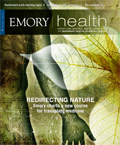Belly up

For years, the pipe-smoking scientist complained of abdominal pain. Eventually he underwent surgery to reinforce the wall of a large abdominal aortic aneurysm, the cause of his discomfort. Six years later, Albert Einstein died after the aneurysm ruptured.
That was 1955. Today abdominal aortic aneurysms continue to be surgically repaired if found in time. Although many studies explore why aneurysms rupture, few explore why they form in the first place.
Widening and bulging of the aorta, the large artery that runs from the heart into the abdomen, characterize these aneurysms. If the aneurysm ruptures, a person may die from rapid blood loss within minutes. In fact, aneurysms are the 10th leading cause of death in men older than 55. And they are common: 9% of men over 65 harbor one.
Through a bioengineering research partnership, a team of scientists at Emory and Georgia Tech is now studying why and how abdominal aortic aneurysms form and how they can be prevented. The five-year partnership incorporates the expertise of engineers, biologists, and clinicians from a wide range of clinical and academic areas.
"So far, we've shown that areas of disturbed flow in the abdominal aorta are associated with markers of vascular inflammation. That suggests a link between the local hemodynamics and the development of abdominal aortic aneurysms," says Emory professor of medicine and biomedical engineering Robert Taylor, who is leading the study. In other words, areas of disturbed blood flow in the lining of the aorta may predispose people to aneurysm formation.
However, predicting a rupture is extremely difficult. For one thing, patients often are unaware of the aneurysm until it has started leaking or has ruptured.
Studies have shown that people in certain demographic groups are relatively protected from the formation of aneurysms. Women before menopause have a lower incidence, as do African Americans. The same is true for diabetics, although their aneurysms are more likely to rupture once formed.
Being able to predict and prevent these aneurysms could one day avert major surgery to repair them. "I tell patients this is one of our big operations," says Taylor. "It's up there with a bypass. Anytime the belly is open for a long time, there's a fair amount of risk. Knowing how and why these aneurysms form could prevent that." —Robin Tricoles


